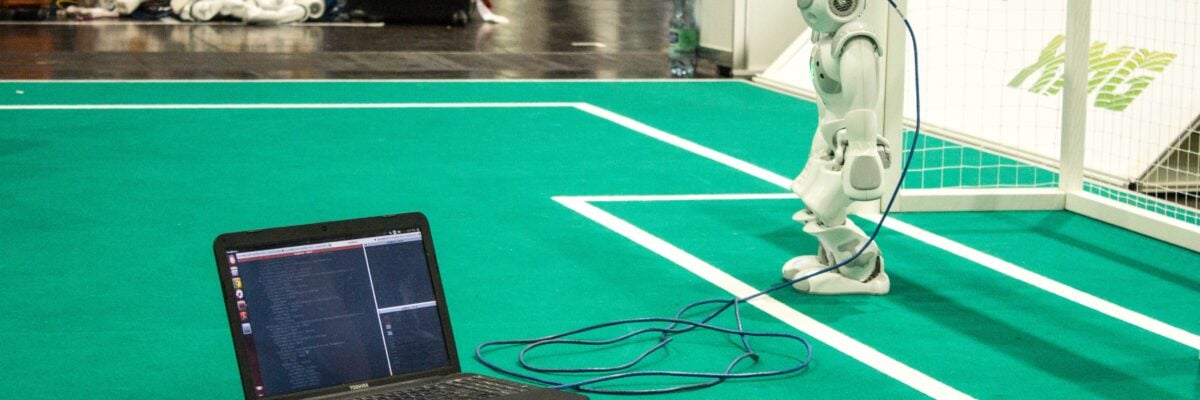This week, representatives from dozens of nations around the globe will come together in heated competition. The best of the best will show off their skills on a soccer field, battling among themselves for the title of World Cup champion. No, not that World Cup (which won’t begin until November). I’m referring instead to a much more unusual type of soccer competition – the “Robot Soccer World Cup,” known colloquially as “RoboCup.”
What is RoboCup?
Twenty-five years ago, 38 teams representing 11 countries participated in the very first RoboCup, an annual competition in which teams of robots compete against each other on a miniature soccer field. The idea was conceived by a group of university researchers with a bold objective: to drive advances in the fields of robotics and artificial intelligence such that, by 2050, “a team of fully autonomous humanoid robot soccer players shall win a soccer game, complying with the official rules of FIFA, against the winner of the most recent World Cup.” Since its inception, the event has taken off, featuring as many as 500 teams from 50 different nations.
The variety of events and competition classes has expanded, too – the RoboCup umbrella now also includes competitions for robots performing workplace and home tasks, as well as robots designed for search and rescue applications. But soccer remains the star of the show, with competitions divided into separate leagues based on the size and design of the various robot competitors. Of particular interest is the “Humanoid League,” featuring robots with human-like body plans and senses, as well as the “Standard Platform League,” (SPL) in which all teams use an identical (humanoid) robot design, so any competitive edge comes solely from the software each team uses to program it.
So how good are these robot soccer players?
… Not very. The choice of soccer as the mode of competition was made in part because this game presents countless challenges from a robotics and artificial intelligence perspective. Robots must sense where they are on the field, where the ball is, and where their teammates are, and then integrate all of this information to select from innumerable possible courses of action. They must coordinate with their teammates and differentiate them from opponents, and of course, they need to be capable of a variety of complex movements and coordination tasks, such as target-oriented walking, kicking, passing, and blocking, all while maintaining their own balance. These challenges are especially difficult under the restrictions imposed by the humanoid design requirements. Calling the humanoid and SPL games “slow-paced” would be an understatement, and robots falling face-forward is a regular (and often very funny) occurrence. Cristiano Ronaldo they are not.
If they’re that bad, why should we care?
Although roboticists may have a long way to go before reaching their 2050 goal, substantial progress has been made since the 1990s. After a RoboCup competition concludes, the researchers gather for a conference at which they share their designs and software and learn from the advances developed by winning teams. The competition can thus layer on new challenges each year, requiring additional levels of sophistication. For instance, in 2017, the organizers added a “mixed team” challenge, in which robots from different teams were paired together to act cooperatively on the same team without any prior knowledge of the pairings.
But the real reason to care about this unusual sporting event is that it offers much broader insights into the role that robotics technology will play in humanity’s future. The challenges facing soccer-playing robots overlap with challenges for many other robotics applications, including medicine. Though human-controlled robotic systems have been in use for over 20 years to enhance precision and optics during minimally-invasive surgeries, we are still a long way from a future in which robotics and artificial intelligence have reached the level necessary for autonomous robot medical “personnel.” Getting there will, for example, require robots to be capable of recognizing a tumor regardless of the tissue in which it resides – much like soccer-playing robots must recognize the soccer ball regardless of whether it’s against a backdrop of the field or another player. Robot medical assistants must be able to interact with other robots as well as with human surgeons, physicians, and patients, much like robot soccer players must act in coordination with their team and react to human referees.
Countless other challenges – some predictable, some not – still stand between current technology and a future with autonomous medical robots, but with any luck, an annual soccer tournament between awkward, collapsing robots might identify and even solve some of those challenges in the meantime. The progress since 1997 has been remarkable, and this year’s RoboCup – the first full competition since 2019 – promises to showcase the most sophisticated technology yet. Sure, these machines might not pose much threat to Ronaldo’s career. But the 2050 World Cup champions may want to watch out.




